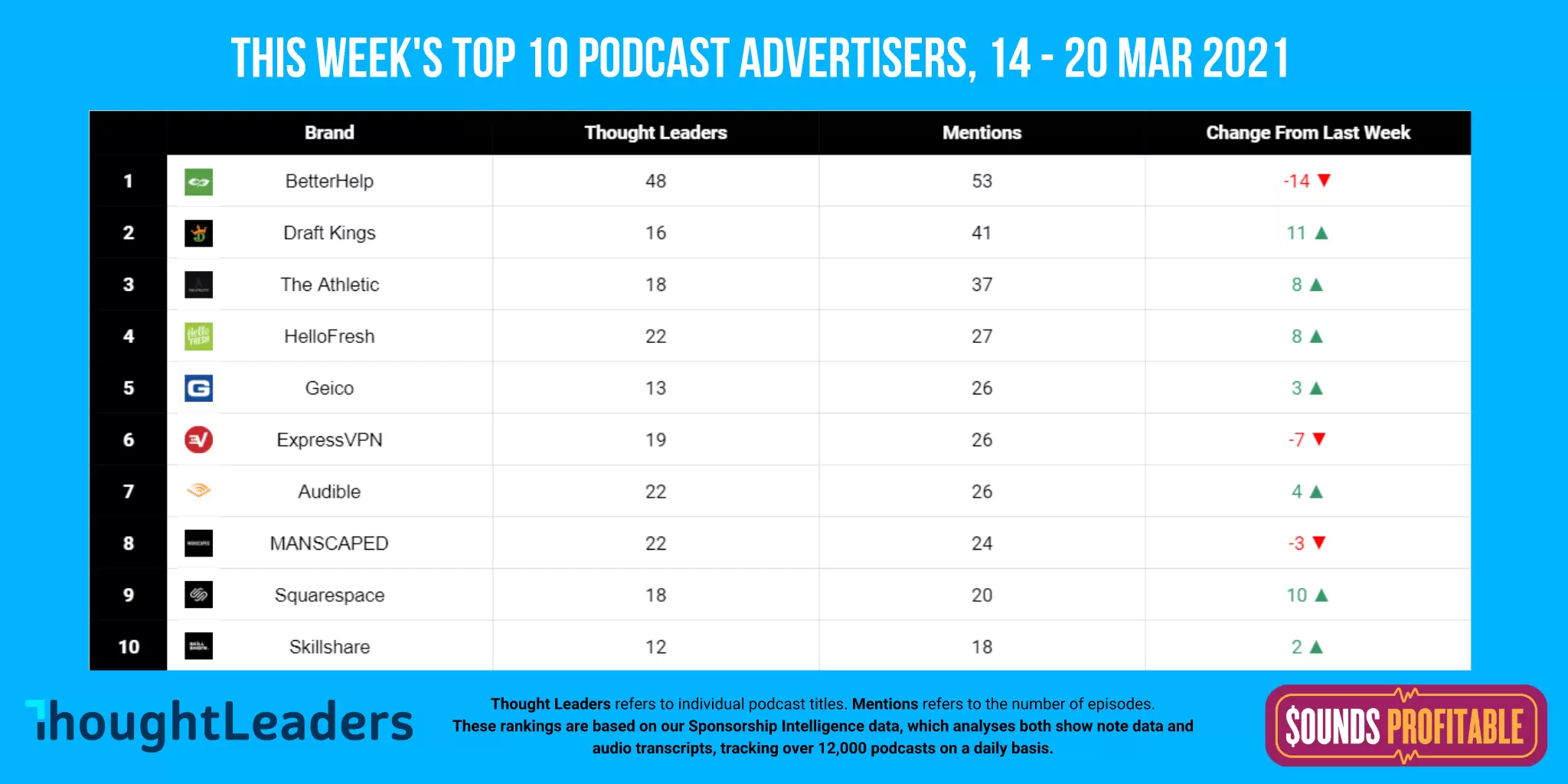Join Thomas Barrasso, Founder of PodLP on this week’s episode of the Sounds Profitable podcast, where we talk more about the impact a US focused certification has on a global podcasting landscape.
Introduction
In advertising technology, data is everything.
Adserving gets all the attention because ultimately that’s where the money comes from, but without analytics, there’s nothing to sell.
Each hosting provider takes their best shot at trying to best represent the downloads and available impressions that each of the podcasts on their platform has. But with the IAB certification process being a best practice instead of proscribing actual requirements, publishers who transfer between hosts can see variances in their numbers as high as 10%.
Nobody is wrong, per se. They just each have their own interpretation.
Hosting provider tools are built specifically for podcast publishers, not advertisers. While data are often exported and shared with ad buyers, it’s not ideal. Ultimately, ad buyers want verifiable numbers that fit their needs, viewed in one central location And that is where prefix analytics partners shine.
This week, I touched base with Podtrac, Blubrry, Chartable, and Podsights to get their help and break down how exactly a prefix URL works and what the value is of using one.
How Does It Work
Downloading a podcast is simply downloading a file.
When I click play on a podcast episode on my phone, the podcast player knows the exact URL to call to download the file because it’s listed in the podcasts RSS feed. Your hosting platform creates the RSS feed to point directly to each of the episodes you’ve uploaded, creating a direct connection from the podcast player to the file, which looks like this:
https://media.whooshkaa.com/show/13119/episode/805615.mp3The only interaction I have as a listener with your podcast is the request to download the episode.
Prefix analytics works by inserting itself into that single exchange. Publishers add the prefix URL to their hosting platform and the hosting platform transforms the link to the media file on every episode listed in the podcasts RSS to look something like this:
https://chtbl.com/track/87369E/https://media.whooshkaa.com/show/13119/episode/805615.mp3Yes, you’re reading that right. In the most unattractive, Frankenstein’s-monster move in podcasting, the two URLs are mashed together. So when the podcast player makes a call for the URL, it hits the prefix partner first:
https://chtbl.com/track/87369E/The podcast player makes a GET request for the episode, which does exactly what it sounds like. That request contains some useful information from the podcast player, including the IP address and device useragent of the listener, along with how much of the episode the podcast player is requesting. Some podcast players ask for the whole episode in the first request, others might ask for it in chunks. But that’s not important right now. What is important is that the prefix analytics provider is making notes on that request.
The analytics provider then—very quickly—replies with a 302 redirect. It also does exactly what it says, redirecting the podcaster player to download the file reference in the second half of the mashed-up URL:
https://media.whooshkaa.com/show/13119/episode/805615.mp3Within milliseconds, the listener’s podcast player receives the episode, and the prefix partner has counted that activity, adding it to the other myriad times that episode’s media file has been requested.
One-Sided Relationship
If you follow the flow, the big thing that stands out is that the prefix partner only sees the call from the podcast player, it doesn’t ever see the response from the hosting provider.
When onboarding a new publisher, prefix partners read through the entire RSS feed of a podcast, downloading every episode. Their goal is to identify exactly how big each episode is and how much of the file is actually audio vs the ID3 tag. The ID3 tag is the first part of the file downloaded, and provides all the information about an episode, including things like the title, description, and the episode artwork.
Why? Because some publishers accidentally (gods, I hope it’s accidentally) include insanely large images for their episodes. In some extreme cases, this can make the ID3 tag larger than the audio file itself!
When a download request comes through, the prefix provider can tell if the podcast player is asking for enough of the file to include one full minute of audio and count it as a download according to the IABv2 podcast spec (Podtrac, Blubrry, and Chartable) or the oDL self certified spec (Podsights).
Requests that come through for less than one minute of audio aren’t immediately discarded. All four partners also accept CDN logs, or the unprocessed download requests, from publishers and are able to identify the difference between the two data sets and use that deviation to discount the requests that don’t ask for one minute of audio.
In most instances, the GET requests for the rest of the episode still go through the full mashed together URL, allowing the prefix partners to further qualify a download. But each partner confirmed that the first request is often enough to know if it’s an actual download. They bring added confidence by employing their own filtering methodology for the rest of the requests.
What’s the Value?
There are a lot of great reasons to use a prefix analytics partner.
One is “normalizing” data from one hosting provider to another. Switching between podcasting hosts is very easy and something that more publishers are getting comfortable with doing. But podcast hosting platforms can’t ingest your analytics from another platform, even if they’re both IAB certified. Since the prefix URL is placed before the episode file, it doesn’t ultimately matter the publishers don’t agree. The prefix partner acts as a constant during the change. And after.
Not everyone will agree on the best way to display analytics. A publisher might love their hosting provider for many reasons, but find themselves struggling to get the data visualized in a way that adds value to their workflow. Adding a prefix partner means you’ve got at least four other reporting interfaces to choose from.
As more ad buyers enter the podcasting space from other digital channels, we may see an increased demand for third-party validation of numbers. Podcasting is unique in that there’s not a lot of wiggle room in how all of this data can be processed between hosting providers or prefix partners, but a big part of the overall digital advertising ecosystem involves using a third-party chosen by the buyer for all billing purposes related to ad campaigns.
Prefix URLs also allow for both ad attribution and impression counting for podcasts with baked-in ads. Since there’s no dynamic ad insertion marker to fire an impression tag server-side, the prefix URL is the only way to add in any form of tracking. The prefix URL also works as a conversion tag, allowing publishers to run campaigns that drive listeners to their podcast from other podcasts prefix URLs, dynamically inserted ads, or even sharing a link to the show through social media or email.
Wrapping It Up
Tracking analytics through redirecting traffic isn’t unique to podcasting nor is it particularly a fresh technology. But it’s also not the only tool each of these partners offer.
Ultimately, I don’t think prefix URLs are where we’re going to settle with third-party analytics. I don’t say that because several prefix partners have found their domains on adblocking lists, preventing listeners from downloading podcasts that use them. After all, that same thing has already happened to some hosting platforms.
I say it because each of these partners, and a fifth entry with Triton Digital, also offer the ability for publishers to share their CDN logs directly for the analytics partner to process. This gives them a far more accurate view of the download statistics, on par with their hosting provider. And more accurate data for these partners lead to new product offerings based on aggregating that data.
Prefix URLs will always be easier. I do think they’ll stay a solution for newer publishers to explore especially as the entry level offering for these partners is usually free. But as a publisher grows in size, we’re going to see more encouragement from analytics providers to ingest the logs directly and increase the accuracy of what they can offer the publisher.
For a space that is often criticized for not having a lot of data, let me say it loud and clear for the people in the cheap seats:
We have a lot of data and we’ve just barely scratched the surface on how best to use it.
These four companies are absolutely the ones to watch. Their reach goes across multiple hosting providers and large numbers of publishers all without being bogged down by serving the podcast, which is a pretty heavy lift product wise.
Their dedication to the best way to view this data while being platform agnostic is going to be what opens this industry up to more eager ad buyers directly while empowering many of you to encourage more advertisers to give podcast advertising the shot it deserves.
Homework – with Yappa
Being hands on with podcast adtech is the easiest way to learn. Week after week we’re hopefully proving that this is more accessible than you thought before. So this week, if you don’t already have a prefix analytics partner, I encourage you to pick one or more and try it out. If you do already have one, check out the free tiers and additional offerings of the others.
Then come back and let me know how they benefit you or where they miss the mark. Oh, and if you don’t have a podcast to try them out on, take that as the encouragement to start one.
We’d love to hear your responses to the question and this article, so click the Yappa image below to leave us a voice message, which we’ll gladly respond to and include in our podcast (with your permission!)
Market Insights – with ThoughtLeaders

Keeping in mind that ThoughtLeaders can only report on the shows that they monitor, we’re still seeing an increase in the mentions last week over the previous. Honestly, I thought we’d see a further decline until the end of the quarter, so this is a nice surprise. I’m genuinely curious to see what new brands pop up as we enter into a new season.
Product Deepdives
I really enjoyed last week’s product deepdive with Spreaker. It was my first time going hands on with the product and I think it has a ton of potential for podcasters of all sizes that are looking for a hosting and monetization platform to take the wheel on filling their unsold ad inventory. I enjoy the strong stance Spreaker takes on how they monetize their publishers inventory, which can be great for publishers not yet set up to do it fully themselves.
If you missed our other product deepdives, with Podscribe and Triton Digital, you can find them on demand on our website. Definitely let us know what you think!


















































































































































































































